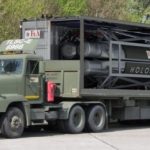Hans-Josef Fell at Energy Watch Group says bluntly that a massive expansion of domestic renewable energy generation over the last decade would not only have saved the planet from a future climate catastrophe, it would be stopping wars today. Firstly, 70% of Russia's state revenues come from oil, natural gas, coal and nuclear energy deals. State revenues fund its military. Secondly, an EU dependent on imports from any geopolitical adversary will … [Read more...]
EU Taxonomy: labelling Gas “green” is a gift to Putin
Many of today’s clean energy technologies were given their first boost in the wake of the 1973 oil crisis, explains William Todts at T&E. He now hopes the current confrontation between NATO and Russia over Ukraine will shake up and deepen Europe’s commitment to the energy transition. But entirely the wrong signal was sent over the New Year, says Todts. He describes the European Commission’s inclusion of gas in the EU Taxonomy for sustainable … [Read more...]
New cooling system for inverters brings electric Heavy-Duty Trucks closer
39% of greenhouse gas emissions in the transport sector comes from heavy-duty trucks. Commercial batteries struggle to deliver enough power to make electrification feasible for heavy-duty applications. Rebecca Martineau at NREL explains how a working prototype, developed with the heavy machinery manufacturer John Deere, is now getting a 378% increase in power density. The key to the innovations rests on a state-of-the-art thermal management … [Read more...]
Micro-nuclear reactors: up to 20MW, portable, safer
Scientists are working on micro-nuclear reactors that are so small they can fit on the back of a truck or a standard 40-foot shipping container, explains Christina Nunez writing for the Argonne National Laboratory. Deliberately small, generating up to 20MW, they could provide zero-carbon power in remote settings or supplement electrical power grid recovery. Another idea would be to locate them on remote highways for re-charging long distance … [Read more...]
EU, U.S. exploring new sources of Rare Earth Minerals, should China limit exports
Reports are emerging that China is considering the restriction of the export of rare earth minerals, as a result of tensions with the U.S. Given China controls around 80% of global supply it would have severe consequences for not just advanced military applications (the presumed primary target) but also clean energy technologies like EVs and wind turbines. However, if the threat is carried out, Lukas Trakimavičius explains how this could backfire … [Read more...]
Nuclear: Does the West’s military need Small Modular Reactors?
The development of small modular nuclear reactors (SMRs), generating up to 300MW, are already getting support for civilian purposes. The military in Russia, China and the U.S. are also interested. It should reduce the reliance on long fuel supply lines, the defence of which costs lives. SMRs would be factory made and delivered on site. But Lukas Trakimavičius says many difficult questions must be answered before the West commits to this solution. … [Read more...]
U.S. Military’s mobile mini-nuclear: fewer fuel supply convoys mean fewer casualties
U.S. Military figures show the resupply of liquid fuel and drinking water for troops in-theatre costs about 4 lives for every 100 convoys. It makes an army more vulnerable and limits movement. That’s why the U.S. Department of Defense is looking at very small modular nuclear reactors (vSMRs): sub-10MW nuclear units. They are already being designed, built and tested. If successful, no refuelling is required for years and the units can be … [Read more...]
Cyberattacks: the military considers micro grids as the answer
European power grids have long been considered as potential targets for major cyberattacks given the enormous damage they could inflict. Successful cyberattacks against power grids could not only cause societal and economic disruptions, but also put a dent in the military readiness of European countries. In the event of a blackout, the lights could go out in town halls and military facilities alike. Lukas Trakimavičius explains how micro grids … [Read more...]








